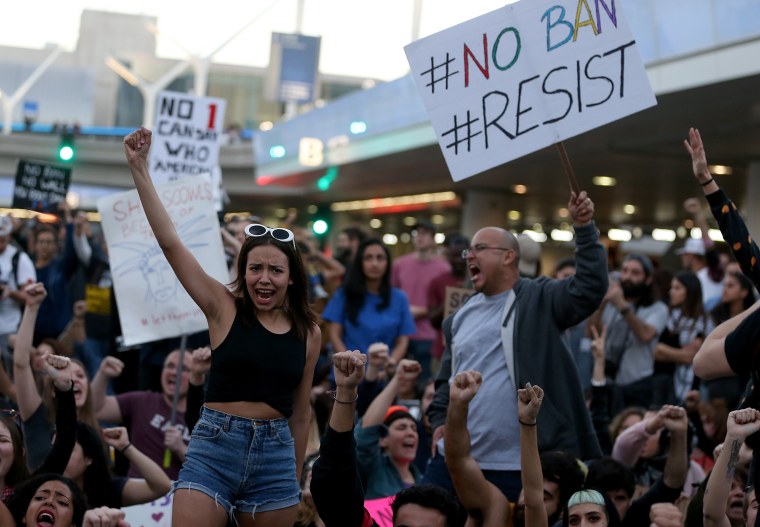After national protests and a weekend of legal wrangling, President Donald Trump's executive order banning refugees and travelers from seven predominantly Muslim countries remained blocked on Monday.
Lawyers for Minnesota and Washington state told a federal appellate court early in the day that restoring the current ban would again "unleash chaos."
This filing with the 9th U.S. Circuit Court of Appeals in San Francisco came after a whirlwind week of protests, legal filings and challenges that followed the president's controversial move, which was blocked by a Washington state federal judge late Friday.
While the White House has said it expected the federal courts to reinstate the ban quickly, the fate of Trump's executive order is still not clear. Here's a look at how we got where we are.
The executive order
Trump signed the controversial order banning some refugees and immigrants on the evening of Jan. 27. The executive order temporarily halted a U.S. refugee program and indefinitely suspended admission of Syrian refugees into the U.S., as well as restricting citizens of seven Muslim majority countries from entering. Those nations are Iraq, Syria, Sudan, Iran, Somalia, Libya and Yemen.
The Trump administration said the order was necessary to keep Americans safe and “keep radical Islamic terrorists out of the United States of America.” The executive order followed Trump’s campaign promise to implement “extreme vetting” for certain refugees and visa seekers.
Protests and airport chaos
After Trump put pen to paper on the executive order, the impact would soon resonate in airports around the world as citizens from the newly restricted countries, some of whom were already mid-flight on the way to the U.S., discovered their documentation was no longer valid.
Refugees and visa holders were detained and questioned in airports nationwide, from New York’s John F. Kennedy International Airport to Los Angeles International Airport. In New York, at least 12 people were detained and questioned for hours.
Lawyers and immigration activists rushed to airports, but said it was unclear how many people were being detained or even sent on planes back to their country of origin.
Trump has since defended the travel restriction and said on Twitter that only 109 people in total were detained and held for questioning.
Trump’s chief of staff Reince Preibus had to clarify on NBC’s Meet the Press on Jan. 29 that the ban "doesn't include green card holders going forward," but also said anyone traveling back and forth from the seven named countries would be subject to further screening.
Protests erupted in airports across the nation the next day as reports of the detentions and confusion in how agencies were interpreting the executive order spread. Thousands gathered and airports and cities for a second day last Sunday to protest the order.
The lawsuits
The American Civil Liberties Union and others filed a lawsuit on Jan. 28 in New York on behalf of individuals subject to the ban. The lead plaintiffs in the case were detained even though they had proper documentation. One had worked for the U.S. military, while the other was threatened because of perceived ties to the U.S., the ACLU said when it unveiled the lawsuit.
Also on Jan. 28, federal judges in several states — including New York, Massachusetts, Washington and California — began issuing orders in response to the slew of lawsuits temporarily halting part of Trump’s executive order and blocking the deportation of people coming into the country with valid visas and others who were legally authorized to enter the country.
There are at least eight major lawsuits opposed to the order, and in seven cases, judges have begun ruling on parts of it.
On Friday, a federal judge in Boston refused to extend a temporary injunction against the immigration order. But later that day, another federal judge U.S. District Court Senior Judge James Robart in Washington temporarily blocked the it.
Soon after and in a blow to the administration, the Department of Homeland Security said it would stop forcing airlines to block travelers with proper visas from boarding their flights. The State Department also announced it had reversed its cancellation of visas under the order.
Trump has a vocal critic of the Washington judge on Twitter since his ruling.
Monday morning wrangling
Early Sunday, the 9th U.S. Circuit Court of Appeals denied the Justice Department’s request to immediately reinstate Trump’s immigration directive.
In its Monday filing, Washington state argued that it derives substantial sales tax revenue from travelers from the affected countries and that businesses and universities based in the state had already suffered as a result of the ban.
Attorneys for Washington and Minnesota argued that reinstating Trump's order would inflict economic damage on both states and emotional distress on their citizens.
Related: Ex-Senior Officials: Travel Ban Not Justifiable
“Those who were abroad were blocked from returning home. Husbands were separated from wives, brothers from sisters, and parents from their children,” the brief said.
Washington state argued that some 7,000 non-citizen immigrants resident in the state are affected by Trump’s executive order in some way.
Both states argued that the ban was unconstitutional.
The Justice Department has until 6 p.m. PT (9 p.m. ET) on Monday to file a brief defending the order so the ball is back in its court.

